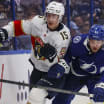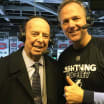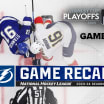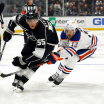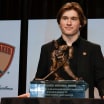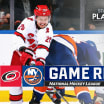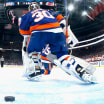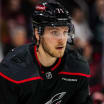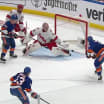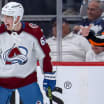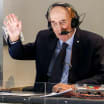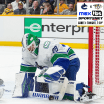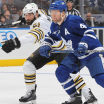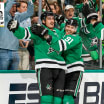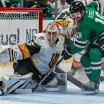This Concussion Evaluation and Management Protocol ("Protocol") sets forth the procedures that Clubs shall follow regarding concussion education, testing, identification, evaluation, and management. The NHL/NHLPA Concussion Evaluation and Management Protocol is consistent with the Consensus Statement on Concussion in Sport - the 5th International Conference on Concussion in Sport held in Berlin, October 2016 ("Berlin Consensus Statement"). The Protocol utilizes the descriptive definition of "concussion" set out in the Berlin Consensus Statement (Medical Handbook 3.6).
NHL concussion evaluation and management protocol for 2022-23 season
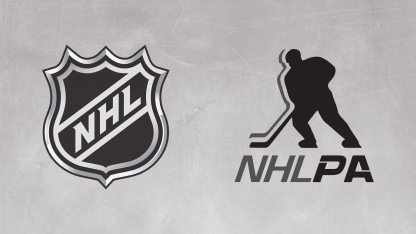
The Protocol that follows applies to NHL Players and Officials, and references to Players shall include Officials, unless otherwise noted below. Consistent with the Berlin Consensus Statement on Concussion in Sport, the evaluation and management of concussion is an individualized process supervised by a Club Physician based on the principles set forth in the Protocol and all information available to him or her. The Club Physician is solely responsible for making the diagnosis of concussion and determining when a Player may return to play.
I. EDUCATION
A. Educational Video: Clubs shall show the 2022 Concussion Educational Video to all Players, Coaches, Club Medical personnel, the Club General Manager and Assistant General Manager ("attendees") no later than the first day of Training Camp. Club Medical Personnel (Team Physicians, including Team Neuropsychologists, and Athletic Trainers) shall be present during the showing of the video to Players. A Player who joins the Club after the commencement of Training Camp and who has not seen the 2022 Concussion Education Video shall be shown the video. All attendees shall sign the attendance sheet upon watching the video (Medical Handbook 3.3.1), which the Club shall submit to the League by the first Monday after the start of Training Camp 2022, or for a Player joining the Club after Training Camp, as applicable.
B. Educational Brochure: Educational Brochure: Clubs shall provide the NHL Concussion Education Program FAQ Brochure (Medical Handbook 3.4) to all Concussion Educational Video attendees, and shall also provide the Brochure to all Players who are diagnosed with a concussion thereafter, and give copies for distribution by NHL Players to family and close friends.
C. Concussion Poster: Clubs shall post the Concussion Poster (Medical Handbook 3.5) in the Club's home, practice, and visiting Club's dressing room and distribute translated versions as appropriate to Players. Translated versions are also posted by the NHLPA on its Player website.
D. Visible Signs Video: Clubs shall show the 2022/23 Visible Signs Training Video to Coaches, Club Medical Personnel, the Club General Manager and Assistant General Manager ("attendees") by the first Sunday after the start of Training Camp. All attendees shall sign the attendance sheet upon watching the video (Medical Handbook 3.2.1), which the Club shall submit to the League by the following Monday.
Both the Visible Signs video and Concussion Education video may be downloaded for future viewing via the "Download" button on the lower right corner of the vimeo link.
Please do not disseminate either of these videos externally or share either with individuals other than the assembled groups. They were created for internal review only. The NHLPA will post the Concussion Educational video on its Player website and it will be posted on the TPS and PHATS websites so that both Players and Club medical personnel will have it available as a resource to review at their convenience.
E. Educational Meetings: It is mandatory for the Medical Director and each Head and Assistant Athletic Trainer to participate (in person, if so scheduled) concussion education sessions normally held at the PHATS/TPS annual meeting, in June of each year. In addition, all members of the Club's primary medical team (physicians who make fitness-to-play decisions regarding concussion on behalf of the Club) are required to attend in person.
Club Consulting Neuropsychologists are required to attend an annual meeting to be scheduled in advance of the 2022/23 season and the NHL session typically held at the annual Sport Neuropsychology Society meeting (Denver, 2023).
It is mandatory for all NHL Head Coaches to participate in the remote zoom session. NHL Assistant Coaches as well as AHL Head and Assistant Coaches may attend the zoom session or will be required to watch a link to the session and to thereafter submit a certification regarding their participation. Clubs are required to ensure participation by Coaches as set forth above.
II. BASELINE TESTING
Clubs shall administer the following baseline testing to all Players at the start of Training Camp (or Conditioning Camp, if applicable), prior to the start of unrestricted (regular colored jersey) play, to the extent possible. For Players joining a Club after the commencement of Training Camp, Clubs shall administer baseline testing prior to the start of play, to the extent possible. Clubs should consult with the Club Consulting Neuropsychologist regarding factors that may interfere with the testing process. Additionally, Clubs should administer tests to Players in a resting state with minimal distractions.
A. SCAT5 App: All Players on a Club's reserve list shall be administered a baseline test with the NHL Modified SCAT5 ("SCAT5") using the SCAT5 App on an annual basis. The SCAT5 App may be administered by team Athletic Trainers, Team Physicians, and the Club's Consulting Neuropsychologist. All persons administering the SCAT5 App at baseline, or who may potentially be administering the SCAT5 App if a concussion is suspected or diagnosed, shall be proficient in the use of the SCAT5 App, including at a minimum the Club's two primary Team Physicians and Athletic Trainers, as well as any Team Physicians who travel to away games with their Club.
\\\Players scoring below the 5th percentile on SCAT5 learning/delayed recall at baseline shall be retested the next day by Club medical personnel with an alternate list. If the Player again scores below the 5th percentile on retest, he shall be referred to the Club Consulting Neuropsychologist who will review SCAT5 results and then give baseline post-injury battery as deemed clinically necessary. The Club Consulting Neuropsychologist shall communicate evaluation findings with Club medical staff and take follow-up steps as clinically indicated.
The Vestibular/Ocular Motor Screening ("VOMS") Test will be added to the SCAT5 App on a trial basis for the 2022-23 season. NHL Team Physicians and NHL Team Athletic Trainers will be trained to use VOMS in person during the 2022 PHATS/TPS meeting, as well as via webinars and video tutorials. For those Clubs who choose to use the VOMS, it is recommended that they administer the measure at baseline and during the suspected injury evaluation, although administration at any point in the injury detection and recovery process is welcome. As the Protocol requires a focal neurological examination, including examination of the vestibular/ocular motor systems, those Clubs who choose to use an ocular motor/vestibular examination other than the VOMS will be asked to record the elements and results of that evaluation in the SCAT5 App during the suspected injury evaluation.
B. ImPACT: Players shall be administered ImPACT baseline testing by the Club's Consulting Neuropsychologist, as follows:
a. Upon entry into the League, Players will be required to have valid baseline tests for 2 consecutive years, and every third year thereafter (two years off); and
b. This sequence will start anew following a diagnosed concussion.
For ImPACT testing, no more than five (5) players should be tested in a group at any one time. Also, due to possible interference in verbal memory tasks, it is recommended that ImPACT be administered prior to the SCAT5 App with as much time as practicable in-between the administration of each test. If it is not possible to administer ImPACT prior to the SCAT5 App, there should be as much time as practicable in between the administration of each test.
C. Paper and Pencil Testing: Players diagnosed with a concussion in the previous season shall be re-evaluated by the Club's Consulting Neuropsychologist at the start of the season with the NHL Paper and Pencil test battery.
The NHL/NHLPA have approved a renorming project for the 2022-23 season, which will require that Club Consulting Neuropsychologists administer a baseline Paper and Pencil battery to 5 Players on each Club. Players will be identified in advance by the League to assure adequate representation across the breadth of cultural/linguistic diversity in the League. Clubs will be given the names of individuals who require such testing, along with the usual list of baseline testing requirements prior to the start of the season.
III. IDENTIFICATION OF POSSIBLE CONCUSSION
This Protocol requires the mandatory removal of a Player from play for an acute evaluation as soon as possible if a concussion is suspected. In addition:
1. VISIBLE SIGNS (MANDATORY EVALUATION)
If any of the following visible signs occurs after a direct blow to the head or a blow to the body that causes acceleration/deceleration of the head ("indirect blow to the head"), the Club shall remove the Player from the playing environment and escort the player to a distraction-free environment for an acute evaluation:
a) "Lying Motionless on the Ice": A Player lies motionless on the ice or falls to the ice in an unprotected manner (i.e., without stretching out his hands or arms to lessen or minimize his fall).
b) "Motor Incoordination/Balance Problems": A Player staggers, struggles to get up or skate properly, appears to lose his balance, buckles, trips or falls, or stumbles while getting up, trying to get up, or skating.
c) "Blank or Vacant Look": A Player has a blank or vacant look.
d) "Slow to Get Up"1: Except as noted in section III(2) below, Player is slow to get up following any of the below mechanisms of injury:
• a blow to the Player's head or upper torso from another Player's shoulder;
• the Player's head makes contact with the ice;
• the Player is punched in the head (including any part of his face) by an ungloved fist during a fight.
2. VISIBLE SIGNS (DISCRETIONARY EVALUATION): If a Player is Slow to Get Up following a mechanism of injury other than the three listed above in section III(1)(d) after a direct or indirect blow to the head, removal from play is not mandatory and Club Medical Personnel shall exercise their medical judgment as to whether to remove the Player for an acute evaluation.
3. CONCUSSION SYMPTOMS
If a Player reports or exhibits one or more of the following Symptoms after a direct or indirect blow to the head that leads Club Medical Personnel to suspect a concussion, it is mandatory that the Club conduct an acute evaluation of the Player. Symptoms may not be present immediately after a blow and may take 24-48 hours, or longer, to develop.
Physical/Somatic:
Headache Sensitivity to light
Pressure in head Sensitivity to noise
Neck Pain Feeling slowed down
Nausea/vomiting Don't feel right
Dizziness Fatigue/low energy
Blurred Vision Drowsiness
Balance Problems
Cognitive:
Difficulty concentrating
Difficulty remembering
Confusion
Feeling like in a fog
Emotional/Psychological:
More emotional
Irritability
Sadness
Nervous/anxious
Sleep Disturbances:
Trouble falling asleep (if applicable)
Although the symptoms listed above are typical, the list is not exhaustive. For example, other symptoms such as slowed processing speed (thinking), tinnitus, slower reaction time, sleeping too much, inability to stay asleep, and word-finding difficulties, are commonly seen with this injury. In addition, it is important to recognize:
• Symptoms vary from Player to Player.
• Symptoms associated with concussion are not unique to concussion and frequently occur without injury (e.g., headache, fatigue). Players will be educated that they should report all symptoms to Club Medical Personnel who will determine if the symptom is suggestive of a concussion.
In addition, if a Player exhibits any other sign, symptom or behavior that leads Club Medical Personnel to suspect that a Player has sustained a concussion, the Club shall remove the Player for an acute evaluation by Club Medical Personnel.* Such observations should be recorded in the SCAT5 App.
IV. IN-GAME IDENTIFICATION - ROLES AND RESPONSIBILITIES
The identification and removal of Players who require an acute evaluation for possible concussion pursuant to this Protocol is a Club-level responsibility.
To assist Clubs, Central League Spotters and In-Arena League Spotters (together "League Spotters") will also observe Players' behavior during NHL Games to identify Players who exhibit visible signs of possible concussion pursuant to this Protocol.
Central League Spotters are certified Athletic Trainers/Therapists with hockey expertise. Central League Spotters will observe Games from the NHL Offices via live game broadcast using multiple feeds. In-Arena League Spotters will be Off-Ice Officials who will be dedicated to observing Games live in the arena. In-Arena League Spotters will view games from the HITS area where space permits.
A League Spotter shall promptly notify Club Medical Personnel each time a Player exhibits an observed visible sign following a direct or indirect blow to the head, regardless of whether such Player is attended to by Club Medical Personnel on the ice, at the bench, or in the locker room, and regardless of whether an evaluation is mandatory or discretionary.
Removal and evaluation of a Player will be required if the Central League Spotter determines that a mandatory evaluation is warranted, even if the In-Arena League Spotter and/or Club Medical Personnel disagree that a visible sign or a mechanism of injury has occurred or been exhibited. If the Central League Spotter communicates a visible sign triggering an evaluation in the discretion of the Club's Medical Personnel, and the Club's Medical Personnel did not see the event, such Club Medical Personnel shall, as soon as reasonably possible following the communication (for example, during the next television time-out or intermission if the next break in play is the intermission), check in with the Player or review the video clip of the event, or both, to determine if an acute evaluation is warranted. If the In-Arena League Spotter communicates to the Central League Spotter a visible sign that was observed off camera, that visible sign shall then be communicated to Club Medical Personnel.
If an Official observes a Player who is lying motionless, has motor incoordination/balance problems, or a blank or vacant look, after a direct or indirect blow to the head, the Official shall report it to the Club Medical Personnel and the Player shall be removed from the playing environment and evaluated. If the Official observes any of these three (3) visible signs after a Player is punched in the head/face by an ungloved fist during a fight, the Official shall bring the Player to the Club Medical Personnel for an immediate acute evaluation prior to the Player serving his penalty (if applicable) in the penalty box. An immediate acute evaluation in lieu of serving a penalty in the penalty box shall also occur if the Official is notified that the League Spotter has determined that a mandatory evaluation is warranted, or the Club Medical Personnel have advised that an evaluation shall occur.
Club Medical Personnel shall continue to identify and promptly remove Players who, on the basis of this Protocol, require an acute evaluation for possible concussion, and need not wait for a call from the League Spotters.
V. ACUTE EVALUATION
he Club Physician and/or Club Athletic Trainer/Therapist (when reasonably possible, together) shall conduct a clinical assessment of the Player in a resting state, in a distraction-free environment . Part of the clinical assessment shall involve the SCAT5 App, which must be completed in full unless the Player is clinically unable to do so. Club Medical Personnel shall also conduct a focused neurological examination, including assessment of the vestibular and ocular motor systems, and history and, review video of the event (unless unavailable) in the Club's medical room to observe any visible signs as well as the mechanism of suspected injury. If the Club Physician verifies that the Player experienced loss of consciousness or ataxia from a direct or indirect blow to the head, this shall result in a diagnosis of concussion. If it is determined that the suspected loss of consciousness or ataxia did not result from a direct or indirect blow to the head, the reason(s) for such determination shall be recorded in the SCAT5 App. In connection with their clinical assessment of the Player, additional evaluation methods may be used at the Club Physician's discretion. In all circumstances, the Club Physician shall assess the Player in person and shall be solely responsible for determining whether or not the Player is diagnosed as having a concussion. The home Club Physician shall fulfill this function for Players on the visiting team if the visiting Club does not have a Physician travelling with the Club.
The information acquired from the SCAT5 may be used by the Club Physician to assist him/her in clinical decision-making and should not be used in isolation either to make the diagnosis of concussion or return-to-play decisions. The SCAT App contains normative values and reliable change indicies which provide a clinical context for the scores on certain test parameters. It is important to note that a "normal" performance on the SCAT5 does not exclude a concussion diagnosis. Interpretation of the SCAT5 subtest scores is facilitated by reference to the NHL SCAT5 Normative Data Tables and Interpretation Guidelines. In situations where Players are diagnosed with concussion, the post concussion symptom scale can be quite useful in tracking recovery over time. As well, it is further noted that any symptom information collected via the SCAT5 or other symptom inventory, evaluation tool, or neurological history in this acute setting should be considered in a comprehensive clinical context and that symptoms consistent with concussion may have other origins.
If the SCAT5 App is not functioning properly, the Club Physician and/or Athletic Trainer/Therapist shall administer the SCAT5 using the paper form (Medical Handbook 3.7) and the data from the paper form shall thereafter be entered into the SCAT5 App and identified as a manual entry in the App.
If, after the evaluation noted above, the Club Physician determines that the Player is not diagnosed with concussion, the Player may return to play at the Club Physician's discretion. Evolving and delayed-onset symptoms of concussion are well documented and highlight the need to follow-up with a player after a suspected concussion regardless of a negative acute evaluation. Therefore, Club Medical Personnel shall follow-up with the Player 24 hours after an incident where there was a clinical suspicion of concussion to inquire whether any concussion symptoms have subsequently developed.
In situations where a clinical assessment has been conducted and the Club Physician determines that he or she does not have definitive information to either make or exclude a diagnosis of concussion, the diagnosis may be deferred and documented in the SCAT5 App. If a diagnosis of concussion is deferred, the Player shall not be returned to play and a follow-up clinical assessment, which at a minimum should include a complete SCAT5, must be conducted within 24 hours, at which point a definitive diagnosis shall be made or excluded.
VI. MANAGEMENT OF CONCUSSION
Concussion symptoms might develop immediately after a blow to the head or body, or they might evolve over time (hours or days). Consequently, Players diagnosed with a concussion should continue to be monitored and evaluated over time.
Players who are diagnosed with a concussion after the acute evaluation shall not return to play or to practice on the same day, irrespective of the resolution of all concussion symptoms.
• Specifically, Players who are diagnosed with a concussion should undergo an initial, brief period of physical and cognitive rest (e.g., 24-48 hours).
• Players can then become gradually and progressively more exposed to activities (a "graded return-to-play progression") that do not provoke cognitive and physical symptoms (i.e., increased activity level should not bring on or worsen symptoms).
An example of a graded return-to-play progression is provided below. Generally, each step should take 24 hours. However, the time frame at each step may vary with Player age, history, etc., and management must be individualized. Club Medical Personnel should monitor progression through the exertional stages as well as continue to consider concurrent morbidities (e.g., migraine, neck, mood, sleep, etc.).
| Stage | Aim | Activity | Goal |
| --- | --- | --- | --- |
| 1 | Symptom-limited activity | Daily activities that do not provoke symptoms | Gradual reintroduction of social,
family, and team-related activities |
| 2 | Introduction of
aerobic exercise | Stationary cycling at slow to medium pace,
limiting head movement. Introduction of
functional movement patterns in the 3-planer
motions; no resistance training | Increase heart rate |
| 3 | Progression of
intensity and
duration | Interval training (e.g., stationary bike,
treadmill, elliptical, etc.) and light resistance
training | Establish capacity for cardiorespiratory exertion |
| 4 | On-ice non-contact activity | Begin with skating around the rink, with gradual progression of both intensity of exercise and magnitude of movement, with low risk of head impact | Establish capacity of sport-specific movement that involve progressively greater motion |
| 5 | Non-contact drills | Continue with intensity established in the previous stage, but now add additional cognitive, sensory, and visual tracking burdens; this typically includes the involvement of coaches and/or teammates (e.g., puck handling, shooting, positional play). Off-ice activity includes introduction of resistance training and plyometrics | Establish sport-specific training with additional cognitive, sensory, and visual burden, plus exertion with resistance training |
| 6 | Controlled body
contact | On-ice activity shall involve controlled body contact (e.g., with coaches or teammates) and cognitively complex drills simulating game situations. | Restore confidence and assess functional skills by coaching staff |
Once a Player diagnosed with concussion is determined by the Club Physician to be free of concussion-related symptoms at rest and upon exertion, the Player shall be referred to the Club's Consulting Neuropsychologist (or, if on the road, a Consulting Neuropsychologist from another team) for a post-concussion evaluation. This evaluation typically occurs prior to the Player engaging in on-ice activity involving controlled body contact, but must occur prior to returning to live game play. At a minimum, the Club's Consulting Neuropsychologist's post-injury evaluation shall consist of a clinical interview, and administration of ImPACT and the NHL Paper and Pencil neuropsychological test battery.
In order to facilitate this evaluation, Club Consulting Neuropsychologists should be advised as soon as a Player is diagnosed with a concussion. Club Consulting Neuropsychologists should be provided with baseline and post-injury SCAT5 data and narratives/reports of the acute medical evaluation, as well as subsequent symptom tracking for review as part of the post-injury assessment.
A Club Physician may request a neuropsychological evaluation prior to full symptom resolution when clinical reasons exist for doing so (e.g., prolonged recovery, complex clinical presentation).
Once complete, the Club Consulting Neuropsychologist shall convey the results of the evaluation to the Club Physician or Club Athletic Trainer (preferably both).
Although neuropsychological test data are very useful in assessing the neurocognitive sequelae of concussion, they should not be used in isolation to make the diagnosis of concussion or as the sole determinant for return-to-play.
VIII. RETURN TO PLAY
A Player may return to unrestricted play when: (1) there is complete recovery of concussion-related symptoms at rest; (2) there is no emergence of concussion-related symptoms at exertion levels required for competitive play and a graded return-to-play progression has been completed and (3) the Player has been judged by the Club's Physician to have returned to his neurological baseline and neurocognitive baseline following an evaluation by the Club Consulting neuropsychologist.
The Club Physician remains solely responsible for making return-to-play decisions based on these parameters, including in circumstances where the Player is referred to a consultant for management and treatment. Prior to making the return to play decision, the Club Physician shall ensure that all aspects of the Protocol have been satisfied, including referral and completion of a neuropsychological assessment.
IX. COMPLIANCE
Sanctions will be imposed on Clubs who do not comply with the Protocol, including Clubs who:
(1) do not remove a Player who requires a mandatory evaluation, and/or (2) do not use the mandatory assessment tools, including the SCAT5 App as part of its mandatory acute evaluation of a Player, and neuropsychological assessment as part of its return-to-play evaluation. First offenses will result in a minimum fine of $25,000. Subsequent offenses in the same season will result in substantially increased fine amounts.
Players who require a mandatory evaluation and who refuse to leave the bench for an evaluation shall not be put back into the Game, unless and until they are evaluated by the Club's Medical Personnel and cleared to play in accordance with the Protocol.
Issued by the NHL/NHLPA Concussion Subcommittee
Ruben Echemendia (Co-Chair, NHL, Neuropsychologist) Paul Comper (Co-Chair, NHLPA, Neuropsychologist)
Mark Aubry (Team Physician, Ottawa Senators);
Tony Colucci (Team Physician, Detroit Red Wings);
Josh Bloom (Team Physician, Carolina Hurricanes);
Dhiren Naidu (Team Physician, Edmonton Oilers);
Jacques Martin (NHL Coaches Representative)
Maria Dennis (NHLPA Legal),
Julie Grand (NHL Legal),
Jamie Hacker (NHL Legal)
Michael Hutchison (NHLPA, Research Scientist)
Winne Meeuwisse (NHL, Co-Chair of Joint Health and Safety Committee)
Scott Delaney (NHLPA, Co-Chair of Joint Health and Safety Committee)
Paul Ayotte (Team Athletic Trainer, Toronto Maple Leafs); Mike Gapski (Team Athletic Trainer, Chicago Blackhawks); or Matt Sokolowski (Team Athletic Trainer, Colorado Avalanche)
Rob Zamuner (NHLPA Divisional Player Representative)
Jeffrey Kutcher (NHLPA, Neurologist)
